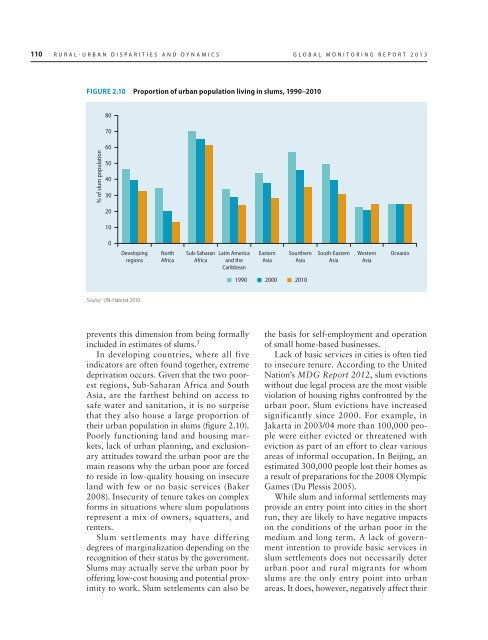rural-urban dynamics_report.pdf - Khazar University
rural-urban dynamics_report.pdf - Khazar University
rural-urban dynamics_report.pdf - Khazar University
Create successful ePaper yourself
Turn your PDF publications into a flip-book with our unique Google optimized e-Paper software.
110 RURAL-URBAN DISPARITIES AND DYNAMICS GLOBAL MONITORING REPORT 2013<br />
FIGURE 2.10 Proportion of <strong>urban</strong> population living in slums, 1990–2010<br />
80<br />
70<br />
% of slum population<br />
60<br />
50<br />
40<br />
30<br />
20<br />
10<br />
0<br />
Developing<br />
regions<br />
North<br />
Africa<br />
Sub-Saharan<br />
Africa<br />
Latin America<br />
and the<br />
Caribbean<br />
Eastern<br />
Asia<br />
Sourthern<br />
Asia<br />
South-Eastern<br />
Asia<br />
Western<br />
Asia<br />
Oceania<br />
1990 2000 2010<br />
Source: UN-Habitat 2010.<br />
prevents this dimension from being formally<br />
included in estimates of slums. 5<br />
In developing countries, where all five<br />
indicators are often found together, extreme<br />
deprivation occurs. Given that the two poorest<br />
regions, Sub-Saharan Africa and South<br />
Asia, are the farthest behind on access to<br />
safe water and sanitation, it is no surprise<br />
that they also house a large proportion of<br />
their <strong>urban</strong> population in slums (figure 2.10).<br />
Poorly functioning land and housing markets,<br />
lack of <strong>urban</strong> planning, and exclusionary<br />
attitudes toward the <strong>urban</strong> poor are the<br />
main reasons why the <strong>urban</strong> poor are forced<br />
to reside in low-quality housing on insecure<br />
land with few or no basic services (Baker<br />
2008). Insecurity of tenure takes on complex<br />
forms in situations where slum populations<br />
represent a mix of owners, squatters, and<br />
renters.<br />
Slum settlements may have differing<br />
degrees of marginalization depending on the<br />
recognition of their status by the government.<br />
Slums may actually serve the <strong>urban</strong> poor by<br />
offering low-cost housing and potential proximity<br />
to work. Slum settlements can also be<br />
the basis for self-employment and operation<br />
of small home-based businesses.<br />
Lack of basic services in cities is often tied<br />
to insecure tenure. According to the United<br />
Nation’s MDG Report 2012, slum evictions<br />
without due legal process are the most visible<br />
violation of housing rights confronted by the<br />
<strong>urban</strong> poor. Slum evictions have increased<br />
significantly since 2000. For example, in<br />
Jakarta in 2003/04 more than 100,000 people<br />
were either evicted or threatened with<br />
eviction as part of an effort to clear various<br />
areas of informal occupation. In Beijing, an<br />
estimated 300,000 people lost their homes as<br />
a result of preparations for the 2008 Olympic<br />
Games (Du Plessis 2005).<br />
While slum and informal settlements may<br />
provide an entry point into cities in the short<br />
run, they are likely to have negative impacts<br />
on the conditions of the <strong>urban</strong> poor in the<br />
medium and long term. A lack of government<br />
intention to provide basic services in<br />
slum settlements does not necessarily deter<br />
<strong>urban</strong> poor and <strong>rural</strong> migrants for whom<br />
slums are the only entry point into <strong>urban</strong><br />
areas. It does, however, negatively affect their

















